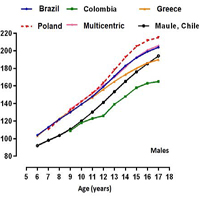 Smart Citations
Smart CitationsSee how this article has been cited at scite.ai
scite shows how a scientific paper has been cited by providing the context of the citation, a classification describing whether it supports, mentions, or contrasts the cited claim, and a label indicating in which section the citation was made.
Regulation data for the horizontal jump of children and adolescents
The Horizontal Jump (HJ) is a daily tool that could be used to categorize the level of muscle fitness performance of the lower limbs. The goal was to compare the muscle fitness with those of international studies and to propose percentiles to assess the HJ performance of children and adolescents. A cross-sectional study was conducted. A total number of 3023 children and adolescents between the ages of 6.0 to 17.9 were studied. Weight, height, waist circumference (WC), and lower limb muscle fitness were evaluated. The student HJ performance values in Chile were inferior when compared to HJ performance in Brazil, Poland and Europe. For the Greek study, differences occurred only from age 6 to 15 years old. In comparison to Colombia, students showed better muscle fitness performance. These differences appeared in childhood and lasted until the beginning of adolescence. Percentiles were created to assess the lower limb fitness being an easy tool to be used and applied to classify lower limb strength.
Downloads
Citations
10.24215/23142561e319
How to Cite
PAGEPress has chosen to apply the Creative Commons Attribution NonCommercial 4.0 International License (CC BY-NC 4.0) to all manuscripts to be published.

 https://doi.org/10.4081/ejtm.2021.9461
https://doi.org/10.4081/ejtm.2021.9461





